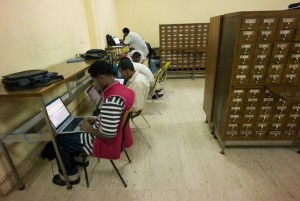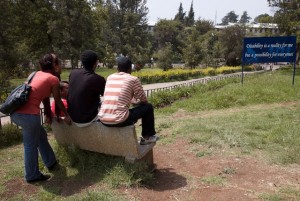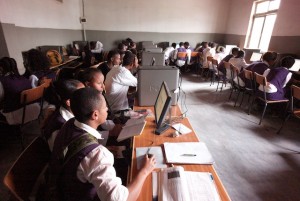There have been some problems with Internet access at the Ghion Hotel the last days, and so I’m posting two entries today: the entry below delineates our ECERC activities on 28 February, and this one delineates our activities March 1.
Ethiopia is 13 hours ahead of Vancouver, and so as we began our day’s meetings at Addis Ababa University, Vancouver was apparently celebrating a successful last day or two of the Olympics. Contemplating that celebration and the Games in light of our current context is troubling. One wonders if it might ever be possible to arrive at a more equitable model of global resource distribution. Here the Olympics haven’t registered at all, of course.

We met with Dean Tirussew, Hailu Gutema (Practicum Coordinator), and Temtim Assefa (ICT Education) in the AAU Faculty of Education at 9:00 am and had a discussion about possible collaborations, ending with the understanding that we will work in the next days toward drafting a research proposal in relation to the digital camera project. We then toured the AAU John Kennedy Library and three computer laboratories, one for graduate students and two for students with disabilities. The former contained perhaps 30 computers and the latter contained approximately 10 computers each — mostly desktop Dell models that appeared to be four to seven years old. All were networked and loaded with Jaws software for individuals with visual impairment. The initiatives at AAU to integrate this segment of the student body are impressive.
Compared to Canada, a much higher portion of the population here is visually or hearing impaired. As well, there are many amputees and individuals with other challenges to mobility caused by diseases such as polio, which is still a major problem in Ethiopia. Raising public awareness about the needs of individuals who are challenged in such ways, as well as the needs of other disenfranchised groups, appears to be a key initiative at present. For example, outside the John Kennedy Library a poignant sign reads, “Disability is a reality for me but a possibility for everyone.” Around the city, as well, are many large billboards speaking to the importance of supporting people with various physical and emotional challenges, and also to the importance of education for all. Beyond these, there are many billboards advocating for women’s and children’s rights. According to two NGO workers with whom we had dinner later in the day, these posters and billboards are a fairly recent initiative, having started to appear within the last two years or so. Many are in English only, though, which makes one ponder the intended audience.

Following our very productive meetings at AAU, Hailu and Temtim took us to the oldest school in Ethiopia, Menelik II Secondary School. The principle was very accommodating and spent a good portion of the afternoon with us. We toured three computer laboratories and spoke to students in grades 11 and 12. One of the classes was just being introduced to Microsoft Word, a second was working with Excel, and a third was learning about Internet Explorer. The last class was particularly intriguing because the students were learning about the web browser without access to the Internet. (Sixteen networked computers are housed in a building away from the school, but the impression we were given is that they are not used for class instruction.) The instructor indicated that the day’s lesson on Internet Explorer was about directory structure.

In the more advanced class working on Excel, I sat amongst three girls sharing one computer and creating a spreadsheet. The one who had the keyboard was particularly adept, and I inquired of her as to whether she had a computer at home. She indicated with a broad smile that she did. Having computer access at home is highly unusual for students at government (public) schools. These schools are poorly resourced and have large class sizes (figures that have been reported to us on this trip range from fifty to eighty). Menelik II is one of the best and most sought after government schools, with three computer laboratories for classrooms and an additional lab for Internet access. Nevertheless, it has a very small book collection, particularly for a school with over 2500 students, and the class sizes are large.

The final class we visited was an English as a second language class learning about passive voice. What was remarkable about this class was the number of students who were hearing impaired (at least five of perhaps fifty in the class). As in the other classes, students numbered several to a desk and sat pressed against each other. The principle pointed out that a “plasma teacher” — a television to accommodate broadcast lessons — was installed in this room. Hailu had indicated earlier that this program is problematic in part because it is a South African initiative and therefore Ethiopian students struggle with the accented English used in the broadcasts. As well, there is some concern that it is a poor attempt to replace teachers. Possibly thinking of such criticisms, the principal emphasized that he views this as a supplemental program not intended in any way to replace teachers.
After speaking with the students for a few minutes we toured the grounds of the adjacent elementary school and observed a physical education class taught by a dynamic teacher who lead the students through callisthenics. Interacting with the bright and keen students in Menelik II was the highlight of our day.
In the evening we were fortunate to join a couple who had been involved in aid work and had lived in Haiti, Rwanda, and Ethiopia for about thirty years, the last ten in Ethiopia, where they moved when Rwanda finally became too dangerous in 1991. Murial is a teacher librarian at a local private school and Tim is a physician working in Aids awareness and prevention. We were also joined by John, who works alongside Murial in teacher librarianship and who spoke extensively of his efforts to build constructivist learning environments in a setting where didactic methods of delivery are almost universal due to constraints such as class size, etc.